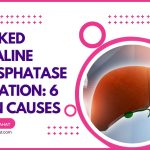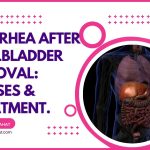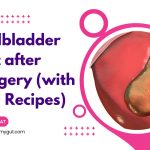Gangrenous Gallbladder (Simplified): Causes, Symptoms, Mortality Rate, & Treatment.
Our content is not intended nor recommended as a substitute for medical advice by your doctor. Use for informational purposes only.
Key insights:
- Gallbladder gangrene is the most frequent complication of acute cholecystitis.
- The incidence of gallbladder gangrene ranges from 2% to 20% of patients with acute cholecystitis.
- The mortality rate from acute cholecystitis is up to 22%.
- The symptoms of the gangrenous gallbladder are similar to acute cholecystitis. And it isn’t easy to detect pre-operatively.
- The definitive treatment of emergency cholecystectomy.
1. What is a gangrenous gallbladder?
Gallbladder gangrene means the death (necrosis) of the gallbladder wall as a complication of acute cholecystitis.
People with gallstones often experience occasional biliary colic that comes and goes away rapidly.
However, a small subset of patients with gallstones may develop severe gallbladder inflammation due to the obstruction of the gallbladder opening by the stone.
The severe inflammation of the gallbladder (called acute cholecystitis) is one of the most common gallbladder diseases. As a result, doctors often remove the gallbladder (cholecystectomy) after the attack of cholecystitis.
In a small subset of people with acute cholecystitis, the inflammation becomes extreme, causes pressure on the gallbladder wall, and hinders the blood supply of the gallbladder.
As a result, the wall of the gallbladder undergoes rapid death (necrosis) and subsequent perforation of the gangrenous part.
The gangrenous gallbladder is a common and serious complication of cholecystitis. Today, we will discuss all you need to know about the gangrenous gallbladder.
2. The incidence of the gangrenous gallbladder? And why is it rare?
If you have gallstones, you have a 1-2% yearly risk of developing acute cholecystitis. In addition, 2% to 20% of the people with acute cholecystitis develop gangrenous gallbladder (on average, one in every ten patients will develop gangrenous gallbladder).
Gallbladder gangrene is NOT a rare complication. It is the most frequent complication in people with acute cholecystitis.
Unfortunately, the differentiation between uncomplicated cholecystitis and gangrenous gallbladder is difficult. Both conditions cause severe abdominal pain and tenderness.
Moreover, the diagnosis of gangrenous cholecystitis can be missed before the operation. This is because doctors will discover the gangrenous gallbladder only during the cholecystectomy operation.
Conclusion:
Gangrenous cholecystitis is not rare; It is one of the most frequent complications of acute cholecystitis.
3. What are the causes of a gangrenous gallbladder?
The following events during acute cholecystitis explain the cause of a gangrenous gallbladder (reference):
A. Gallbladder obstruction.
The most important trigger is the obstruction of the gallbladder’s opening or its duct (the cystic duct). The obstruction is often due to a stone obstructing its opening.
There are two types of obstruction:
- Temporary obstruction after meals: often leads to biliary colics (simple or uncomplicated biliary colic). The obstruction eventually resolves as the gallbladder relaxes again.
- Permanent obstruction of the gallbladder: The gallstone gets stuck in the gallbladder opening resulting in acute calculous cholecystitis.
B. Inflammation and infection of trapped bile.
The permanent obstruction of the gallbladder opening leads to cholecystitis which predisposes to stasis and infection of the bile inside the gallbladder.
Combined obstruction, infection, and inflammation of the gallbladder content begin the process of acute cholecystitis. Inflammatory fluids or pus build up inside the gallbladder, causing a significant increase in the pressure inside it.
C. Gallbladder wall edema and tension.
Severe inflammation inside the gallbladder spreads to its walls leading to intense swelling and inflammation of the gallbladder wall.
The edema of the gallbladder wall and increased tension inside the gallbladder will eventually lead to a decreased blood supply to the bladder wall.
D. Blockage of the blood supply to the gallbladder wall.
As explained above, two factors aid in the blockage of the blood supply:
- Severe gallbladder wall edema due to inflammation.
- Increased pressure inside the gallbladder wall.
Also, the incidence of blockage of blood supply is higher among older people and those with diabetes mellitus due to poor blood vessel health.
These factors eventually lead to death (necrosis) of the gallbladder wall leading to gangrene and perforation.
Predictive (risk) factors of the gangrenous gallbladder (reference):
- Age above 40-45 years.
- Being male.
- White blood cell count > 15,000 /mm3.
- Thick gallbladder wall in the abdominal sonograph (between 5.1 and 6 mm).
- Diabetes mellitus.
4. The symptoms of gangrenous cholecystitis.
Gangrenous cholecystitis is difficult to spot based on symptoms and signs only. However, they present with symptoms similar to uncomplicated cholecystitis in most cases.
Even with imaging and laboratory investigation, some cases will be detected only during the cholecystectomy operation.
However, we will try to enlist the suspicious risk factors, symptoms, and signs that are suggestive of gangrenous cholecystitis:
A. Presence of risk factors:
Patients at higher risk of developing gangrenous cholecystitis include males, ages older than 45 years, with diabetes Mellitus, and those with high white blood cell count and thick gallbladder wall in ultrasonography.
Also, patients with delays in seeking emergency medical help are at higher risk of gangrene and perforation of the gallbladder.
B. Symptoms of acute cholecystitis.
Gallbladder pain can result from:
- Simple gallstones without cholecystitis (uncomplicated biliary colic).
- Acute cholecystitis pain (non-complicated).
- Complicated acute cholecystitis (as with gangrenous cholecystitis.
The three conditions cause biliary pain (right upper abdominal pain that radiates to the back and the right shoulder.
Patients with gangrenous cholecystitis often present with typical pain similar to acute cholecystitis.
However, gangrenous cholecystitis patients may have sepsis signs (see the next section). Also, the pain may become generalized all over the abdomen if perforation occurs (peritonitis). Still, it’s rare as perforation is often confined as an abscess around the gallbladder fundus (pericholecystic abscess) (reference).
The table below illustrates the differences between typical (uncomplicated biliary colic) and acute cholecystitis pain (with or without gangrene) (reference).
| Typical (uncomplicated) gallbladder pain | Complicated gallbladder pain (acute & gangrenous cholecystitis) |
|
| 1. Site | Usually, The right upper quadrant of your abdomen. | The same. |
| 2. Spread | – The pain may spread to the back of the right shoulder. – Also, it spreads to the epigastric area. |
The same. |
| 3. Character | Constant. builds up then disappears gradually. |
The same, but more severe and more prolonged. |
| 4. Duration | At least 30 minutes. It may last up to 6 hours. | It can last more than 6 hours. |
| 5. Relation to food | – Triggered by foods (especially fatty food and large meals. – However, it can start spontaneously. |
Often persistent. Regardless of eating. |
| 6. Comes and goes? | Yes | No |
| 7. Nausea, vomiting. | Often Present. | Present, but very severe and persistent. |
| 8. Associated symptoms | – Heartburn and chest pain. – Bloating, fullness. – Early satiety. – Epigastric pain. |
The same, but more severe. |
| 9. Fever. | Absent. | – Often present. – it is more frequent and severe in gangrenous cholecystitis |
| 10. Jaundice | Absent | Present if there are Bile duct stones. |
| 11. Murphy’s sign (tenderness over the gallbladder area) | Often absent. | – Often present in uncomplicated acute cholecystitis. |
C. Symptoms of sepsis
- Fever.
- Toxic (pale) look.
- Extreme fatigue and tiredness.
- Shortness of breath.
- Fast heartbeats.
- Dizziness, lightheadedness.
- Muscle aches.
- Clammy or sweaty skin.
- Confusion, coma, and low blood pressure (septic shock) are severe cases.
D. Lack of murphy sign.
Murphy sign is a clinical sign that doctors use to diagnose acute cholecystitis.
Your doctor puts his hand on your gallbladder area (right upper abdomen under ribs). Then, he will ask you to take a deep breath.
If you have acute cholecystitis, you will feel a sudden increase in pain with inspiration. Unfortunately, the pain is often severe enough to make you hold inspiration.
In patients with gangrenous cholecystitis, this sign often disappears. So, the early disappearance of murphy sign in a patient with cholecystitis can be a sign of complications rather than improvement.
5. Diagnosis of gangrenous cholecystitis.
The diagnosis of a gangrenous gallbladder is often difficult. However, it is suspected clinically when there are symptoms and signs of sepsis, high TLC, and disappearance of murphy sign.
The diagnosis of gallbladder gangrene with imaging techniques is also not conclusive. Unfortunately, there is no gold standard for diagnosing gangrenous cholecystitis, and most cases are discovered during the operation.
A gallbladder wall thickness of more than 5.1 mm is predictive of gallbladder gangrene but not diagnostic.
Laboratory tests such as leucocytic count and liver enzymes are also not diagnostic.
6. The mortality rate of a gangrenous gallbladder.
The mortality rate from gallbladder gangrene is significantly higher than from uncomplicated acute cholecystitis. Up to 22% of patients with gangrenous cholecystitis die from this condition.
Predictors of mortality include (reference):
- The longer delay time before hospital admission.
- Low white blood cell count (indicating poor immune system response).
- Higher AST, ALT, Alkaline phosphatase, and total bilirubin levels.
- Presence of diabetes mellitus.
- Presence of fluid collection around the gallbladder (in abdominal imaging such as abdominal ultrasound).
- Failure of laparoscopic surgery (with subsequent conversion to open surgery).
7. Treatment and recovery of a gangrenous gallbladder?
A. Emergency surgery.
The definitive treatment of gallbladder gangrene is urgent surgery (laparoscopic or open cholecystectomy).
Patients with gangrenous gallbladder often have perforation and local collection (pericholecystic abscess). Evacuation and removal of the abscess and the gangrenous gallbladder are critical for the treatment.
Antibiotic:
Once suspected, patients with gangrenous gallbladder must receive aggressive antibiotic therapy before and after the operation.
Gangrenous cholecystitis is considered a high-risk intraabdominal infection. TherefTherefore, the the following are the recommended antibiotics (reference):
Single-agent regimen |
|
| Imipenem-cilastatin | 500 mg IV every 6 hours |
| Meropenem | 1 g IV every 8 hours |
| Doripenem | 500 mg IV every 8 hours |
| Piperacillin-tazobactam | 4.5 g IV every 6 hours |
Combination regimen with metronidazole |
|
| ONE of the following: | |
| Cefepime | 2 g IV every 8 hours |
| OR | |
| Ceftazidime | 2 g IV every 8 hours |
| PLUS: | |
| Metronidazole | 500 mg IV or PO every 8 hours |
With surgery and good antibiotics, recovery from gallbladder gangrene is expected. Unfortunately, however, death occurs in a significant proportion of the patients (about one in every five).
- Evidence-based
- Written by a doctor.

Related Posts:
- Diarrhea After Gallbladder Removal: Causes, How Long…
- Fatty Liver Pain: Causes, Mimics, and Treatment;…
- Safest Gallbladder Diet after Surgery (with 60+ Recipes)
- 6 Problems After Gallbladder Removal, Years Later…
- 6 Causes of Bigger Stomach after Gallbladder Surgery…
- Can Gallbladder Pain Affect your Back Only?…





